Deck 8: Exponential and Logarithmic Functions
سؤال
سؤال
سؤال
سؤال
سؤال
سؤال
سؤال
سؤال
سؤال
سؤال
سؤال
سؤال
سؤال
سؤال
سؤال
سؤال
سؤال
سؤال
سؤال
سؤال
سؤال
سؤال
سؤال
سؤال
سؤال
سؤال
سؤال
سؤال
سؤال
سؤال
سؤال
سؤال
سؤال
سؤال
سؤال
سؤال
سؤال
سؤال
سؤال
سؤال
سؤال
سؤال
سؤال
سؤال
سؤال
سؤال
سؤال
سؤال

فتح الحزمة
قم بالتسجيل لفتح البطاقات في هذه المجموعة!
Unlock Deck
Unlock Deck
1/48
العب
ملء الشاشة (f)
Deck 8: Exponential and Logarithmic Functions
1
Evaluate the function  at x = 3.6. Round to 3 decimal places.
at x = 3.6. Round to 3 decimal places.
A)5.287
B)4.680
C)20.055
D)2.572
E)1.690
 at x = 3.6. Round to 3 decimal places.
at x = 3.6. Round to 3 decimal places.A)5.287
B)4.680
C)20.055
D)2.572
E)1.690
2.572
2
Evaluate the function  . Round to 3 decimal places. (You may use your calculator.)
. Round to 3 decimal places. (You may use your calculator.)
A)-1.680
B)1.816
C)-1.816
D)0.229
E)undefined
 . Round to 3 decimal places. (You may use your calculator.)
. Round to 3 decimal places. (You may use your calculator.)A)-1.680
B)1.816
C)-1.816
D)0.229
E)undefined
-1.816
3
Sketch the graph of the function  .
. 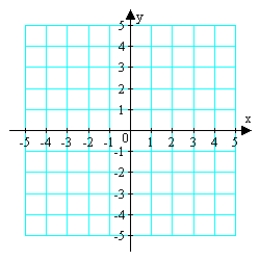
A)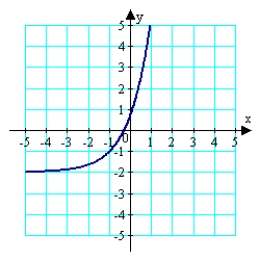
B)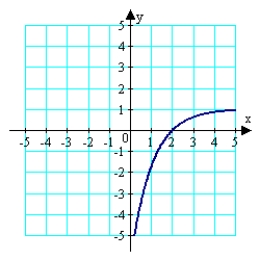
C)
D)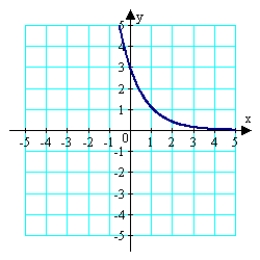
E)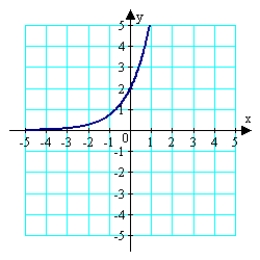
 .
. 
A)

B)

C)

D)

E)


4
Identify the operation that will transform the graph of  into the graph of
into the graph of  .
.
A)g(x) is obtained by shifting f(x) 2 units upward (positive).
B)g(x) is obtained by shifting f(x) 2 units downward (negative).
C)g(x) is obtained by shifting f(x) 2 units to the left (negative).
D)g(x) is obtained by shifting f(x) 2 units to the right (positive).
E)g(x) cannot be obtained by any of these tranforms.
 into the graph of
into the graph of  .
.A)g(x) is obtained by shifting f(x) 2 units upward (positive).
B)g(x) is obtained by shifting f(x) 2 units downward (negative).
C)g(x) is obtained by shifting f(x) 2 units to the left (negative).
D)g(x) is obtained by shifting f(x) 2 units to the right (positive).
E)g(x) cannot be obtained by any of these tranforms.

فتح الحزمة
افتح القفل للوصول البطاقات البالغ عددها 48 في هذه المجموعة.
فتح الحزمة
k this deck
5
Identify the x-intercept of the function  .
.
A)x = 1
B)x = 0
C)x = 4
D)x = 2
E)The function has no x-intercept.
 .
.A)x = 1
B)x = 0
C)x = 4
D)x = 2
E)The function has no x-intercept.

فتح الحزمة
افتح القفل للوصول البطاقات البالغ عددها 48 في هذه المجموعة.
فتح الحزمة
k this deck
6
Evaluate the function  without using a calculator.
without using a calculator.
A)0
B)-1
C)-2
D)4
E)
 without using a calculator.
without using a calculator.A)0
B)-1
C)-2
D)4
E)


فتح الحزمة
افتح القفل للوصول البطاقات البالغ عددها 48 في هذه المجموعة.
فتح الحزمة
k this deck
7
Sketch the graph of the function  .
. 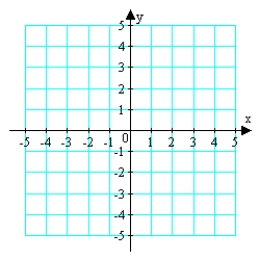
A)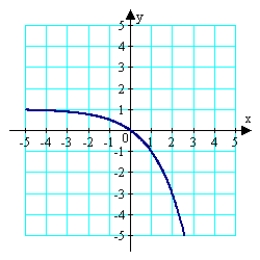
B)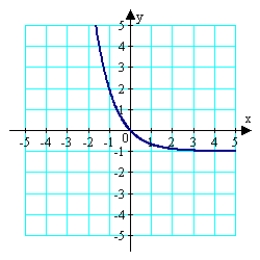
C)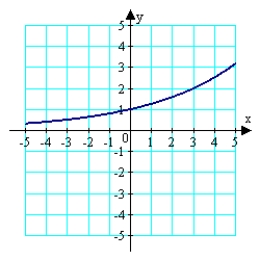
D)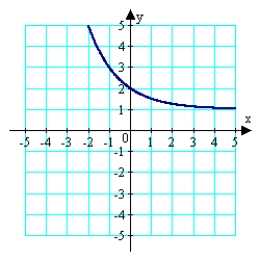
E)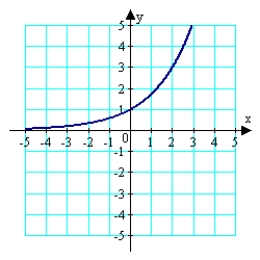
 .
. 
A)

B)

C)

D)

E)


فتح الحزمة
افتح القفل للوصول البطاقات البالغ عددها 48 في هذه المجموعة.
فتح الحزمة
k this deck
8
What is the value of the function  at x = 2.3? Round to 3 decimal places.
at x = 2.3? Round to 3 decimal places.
A)118.806
B)91.605
C)1.851
D)76.221
E)216.302
 at x = 2.3? Round to 3 decimal places.
at x = 2.3? Round to 3 decimal places.A)118.806
B)91.605
C)1.851
D)76.221
E)216.302

فتح الحزمة
افتح القفل للوصول البطاقات البالغ عددها 48 في هذه المجموعة.
فتح الحزمة
k this deck
9
What is the value of the function  at x = 2.5? Round to 3 decimal places.
at x = 2.5? Round to 3 decimal places.
A)0.603
B)0.047
C)7.344
D)-38.124
E)0.000
 at x = 2.5? Round to 3 decimal places.
at x = 2.5? Round to 3 decimal places.A)0.603
B)0.047
C)7.344
D)-38.124
E)0.000

فتح الحزمة
افتح القفل للوصول البطاقات البالغ عددها 48 في هذه المجموعة.
فتح الحزمة
k this deck
10
Evaluate the function  without using a calculator.
without using a calculator.
A)-2
B)
C)2
D)
E)undefined
 without using a calculator.
without using a calculator.A)-2
B)

C)2
D)

E)undefined

فتح الحزمة
افتح القفل للوصول البطاقات البالغ عددها 48 في هذه المجموعة.
فتح الحزمة
k this deck
11
Evaluate the function  at x = 240. Round to 3 decimal places.
at x = 240. Round to 3 decimal places.
A)3.310
B)96,480.000
C)1324.082
D)1764.558
E)404.010
 at x = 240. Round to 3 decimal places.
at x = 240. Round to 3 decimal places.A)3.310
B)96,480.000
C)1324.082
D)1764.558
E)404.010

فتح الحزمة
افتح القفل للوصول البطاقات البالغ عددها 48 في هذه المجموعة.
فتح الحزمة
k this deck
12
Use a graphing utility to graph the function. 
A)
B)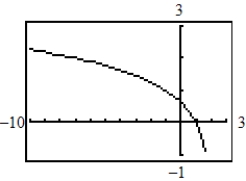
C)
D)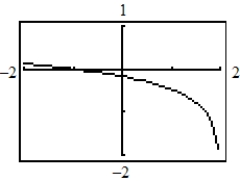
E)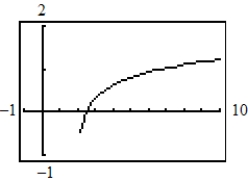

A)

B)

C)

D)

E)


فتح الحزمة
افتح القفل للوصول البطاقات البالغ عددها 48 في هذه المجموعة.
فتح الحزمة
k this deck
13
Evaluate the function  . Round to 3 decimal places. (You may use your calculator.)
. Round to 3 decimal places. (You may use your calculator.)
A)1.546
B)0.671
C)1.280
D)-0.347
E)undefined
 . Round to 3 decimal places. (You may use your calculator.)
. Round to 3 decimal places. (You may use your calculator.)A)1.546
B)0.671
C)1.280
D)-0.347
E)undefined

فتح الحزمة
افتح القفل للوصول البطاقات البالغ عددها 48 في هذه المجموعة.
فتح الحزمة
k this deck
14
Rewrite the exponential equation  in logarithmic form.
in logarithmic form.
A)
B)
C)
D)
E)
 in logarithmic form.
in logarithmic form.A)

B)

C)

D)

E)


فتح الحزمة
افتح القفل للوصول البطاقات البالغ عددها 48 في هذه المجموعة.
فتح الحزمة
k this deck
15
Let Q represent a mass of radioactive radium (226Ra) (in grams), whose half-life is 1599 years. The quantity of radium present after t years is  Determine the quantity present after 100 years. Round to the nearest hundredth of a gram.
Determine the quantity present after 100 years. Round to the nearest hundredth of a gram.
A)0.00 g
B)0.16 g
C)0.96 g
D)4.79 g
E)5.00 g
 Determine the quantity present after 100 years. Round to the nearest hundredth of a gram.
Determine the quantity present after 100 years. Round to the nearest hundredth of a gram.A)0.00 g
B)0.16 g
C)0.96 g
D)4.79 g
E)5.00 g

فتح الحزمة
افتح القفل للوصول البطاقات البالغ عددها 48 في هذه المجموعة.
فتح الحزمة
k this deck
16
Identify the operation that will transform the graph of  into the graph of
into the graph of  .
.
A)g(x) is obtained by reflecting f(x) in the x-axis then shifting upward 2 units.
B)g(x) is obtained by reflecting f(x) in the y-axis then shifting upward 2 units.
C)g(x) is obtained by reflecting f(x) in the x-axis then shifting downward 2 units.
D)g(x) is obtained by reflecting f(x) in the y-axis then shifting downward 2 units.
E)g(x) cannot be obtained by any of these tranforms.
 into the graph of
into the graph of  .
.A)g(x) is obtained by reflecting f(x) in the x-axis then shifting upward 2 units.
B)g(x) is obtained by reflecting f(x) in the y-axis then shifting upward 2 units.
C)g(x) is obtained by reflecting f(x) in the x-axis then shifting downward 2 units.
D)g(x) is obtained by reflecting f(x) in the y-axis then shifting downward 2 units.
E)g(x) cannot be obtained by any of these tranforms.

فتح الحزمة
افتح القفل للوصول البطاقات البالغ عددها 48 في هذه المجموعة.
فتح الحزمة
k this deck
17
Write the logarithmic equation  in exponential form.
in exponential form.
A)
B)
C)
D)
E)
 in exponential form.
in exponential form.A)

B)

C)

D)

E)


فتح الحزمة
افتح القفل للوصول البطاقات البالغ عددها 48 في هذه المجموعة.
فتح الحزمة
k this deck
18
Identify the x-intercept of the function  .
.
A)
B)
C)-4
D)8
E)The function has no x-intercept.
 .
.A)

B)

C)-4
D)8
E)The function has no x-intercept.

فتح الحزمة
افتح القفل للوصول البطاقات البالغ عددها 48 في هذه المجموعة.
فتح الحزمة
k this deck
19
Write the exponential equation  in logarithmic form.
in logarithmic form.
A)
B)
C)
D)
E)
 in logarithmic form.
in logarithmic form.A)

B)

C)

D)

E)


فتح الحزمة
افتح القفل للوصول البطاقات البالغ عددها 48 في هذه المجموعة.
فتح الحزمة
k this deck
20
Rewrite the logarithmic equation  in exponential form.
in exponential form.
A)
B)
C)
D)
E)
 in exponential form.
in exponential form.A)

B)

C)

D)

E)


فتح الحزمة
افتح القفل للوصول البطاقات البالغ عددها 48 في هذه المجموعة.
فتح الحزمة
k this deck
21
Approximate the solution to  . Round to 3 decimal places.
. Round to 3 decimal places.
A)2.906
B)8.178
C)4.299
D)0.065
E)528.298
 . Round to 3 decimal places.
. Round to 3 decimal places.A)2.906
B)8.178
C)4.299
D)0.065
E)528.298

فتح الحزمة
افتح القفل للوصول البطاقات البالغ عددها 48 في هذه المجموعة.
فتح الحزمة
k this deck
22
Rewrite the logarithm  in terms of the common logarithm (base 10).
in terms of the common logarithm (base 10).
A)
B)
C)
D)
E)
 in terms of the common logarithm (base 10).
in terms of the common logarithm (base 10).A)

B)

C)

D)

E)


فتح الحزمة
افتح القفل للوصول البطاقات البالغ عددها 48 في هذه المجموعة.
فتح الحزمة
k this deck
23
Find the exact value of  without using a calculator.
without using a calculator.
A)
B)1
C)11
D)
E)4
 without using a calculator.
without using a calculator.A)

B)1
C)11
D)

E)4

فتح الحزمة
افتح القفل للوصول البطاقات البالغ عددها 48 في هذه المجموعة.
فتح الحزمة
k this deck
24
An initial investment of $7000 grows at an annual interest rate of 3% compounded continuously. How long will it take to double the investment?
A)23.10 years
B)24.10 years
C)24.00 years
D)23.00 years
E)1 year
A)23.10 years
B)24.10 years
C)24.00 years
D)23.00 years
E)1 year

فتح الحزمة
افتح القفل للوصول البطاقات البالغ عددها 48 في هذه المجموعة.
فتح الحزمة
k this deck
25
Approximate the solution of  to 3 decimal places. (You may use a graphing utility.)
to 3 decimal places. (You may use a graphing utility.)
A)8.792
B)12.294
C)7.222
D)-6.489
E)7.511
 to 3 decimal places. (You may use a graphing utility.)
to 3 decimal places. (You may use a graphing utility.)A)8.792
B)12.294
C)7.222
D)-6.489
E)7.511

فتح الحزمة
افتح القفل للوصول البطاقات البالغ عددها 48 في هذه المجموعة.
فتح الحزمة
k this deck
26
Solve the equation  for x using the One-to-One Property.
for x using the One-to-One Property.
A)11
B)-9
C)-11
D)0
E)The equation has no solution.
 for x using the One-to-One Property.
for x using the One-to-One Property.A)11
B)-9
C)-11
D)0
E)The equation has no solution.

فتح الحزمة
افتح القفل للوصول البطاقات البالغ عددها 48 في هذه المجموعة.
فتح الحزمة
k this deck
27
Approximate the solution of  to 3 decimal places. (You may use a graphing utility.)
to 3 decimal places. (You may use a graphing utility.)
A)-3.253
B)0.539
C)-0.639
D)2.989
E)0.187
 to 3 decimal places. (You may use a graphing utility.)
to 3 decimal places. (You may use a graphing utility.)A)-3.253
B)0.539
C)-0.639
D)2.989
E)0.187

فتح الحزمة
افتح القفل للوصول البطاقات البالغ عددها 48 في هذه المجموعة.
فتح الحزمة
k this deck
28
Condense the expression  to the logarithm of a single term.
to the logarithm of a single term.
A)
B)
C)
D)
E)
 to the logarithm of a single term.
to the logarithm of a single term.A)

B)

C)

D)

E)


فتح الحزمة
افتح القفل للوصول البطاقات البالغ عددها 48 في هذه المجموعة.
فتح الحزمة
k this deck
29
Approximate the solution to  . Round to 3 decimal places.
. Round to 3 decimal places.
A)-0.632
B)0.333
C)1.164
D)2.718
E)0.222
 . Round to 3 decimal places.
. Round to 3 decimal places.A)-0.632
B)0.333
C)1.164
D)2.718
E)0.222

فتح الحزمة
افتح القفل للوصول البطاقات البالغ عددها 48 في هذه المجموعة.
فتح الحزمة
k this deck
30
Simplify the expression  .
.
A)4
B)-8
C)2
D)-36
E)The expression cannot be simplified.
 .
.A)4
B)-8
C)2
D)-36
E)The expression cannot be simplified.

فتح الحزمة
افتح القفل للوصول البطاقات البالغ عددها 48 في هذه المجموعة.
فتح الحزمة
k this deck
31
Find the exact value of  without using a calculator.
without using a calculator.
A)2.25
B)9
C)4
D)5
E)4.5
 without using a calculator.
without using a calculator.A)2.25
B)9
C)4
D)5
E)4.5

فتح الحزمة
افتح القفل للوصول البطاقات البالغ عددها 48 في هذه المجموعة.
فتح الحزمة
k this deck
32
Condense the expression  to the logarithm of a single term.
to the logarithm of a single term.
A)
B)
C)
D)
E)
 to the logarithm of a single term.
to the logarithm of a single term.A)

B)

C)

D)

E)


فتح الحزمة
افتح القفل للوصول البطاقات البالغ عددها 48 في هذه المجموعة.
فتح الحزمة
k this deck
33
Condense the expression  to the logarithm of a single term.
to the logarithm of a single term.
A)
B)
C)
D)
E)
 to the logarithm of a single term.
to the logarithm of a single term.A)

B)

C)

D)

E)


فتح الحزمة
افتح القفل للوصول البطاقات البالغ عددها 48 في هذه المجموعة.
فتح الحزمة
k this deck
34
Evaluate the logarithm  using the change of base formula. Round to 3 decimal places.
using the change of base formula. Round to 3 decimal places.
A)0.395
B)-0.434
C)-2.778
D)-0.360
E)0.172
 using the change of base formula. Round to 3 decimal places.
using the change of base formula. Round to 3 decimal places.A)0.395
B)-0.434
C)-2.778
D)-0.360
E)0.172

فتح الحزمة
افتح القفل للوصول البطاقات البالغ عددها 48 في هذه المجموعة.
فتح الحزمة
k this deck
35
Identify the graph that represents the function. 
A)
B)
C)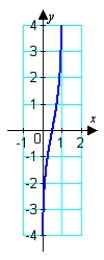
D)
E)

A)

B)

C)

D)

E)


فتح الحزمة
افتح القفل للوصول البطاقات البالغ عددها 48 في هذه المجموعة.
فتح الحزمة
k this deck
36
Solve  for x.
for x.
A)
B)
C)
D)
E)no solution
 for x.
for x.A)

B)

C)

D)

E)no solution

فتح الحزمة
افتح القفل للوصول البطاقات البالغ عددها 48 في هذه المجموعة.
فتح الحزمة
k this deck
37
Use a graphing utility to approximate the solution to  . Round to 3 decimal places.
. Round to 3 decimal places.
A)4.772
B)3.772
C)2.386
D)1.886
E)no solution
 . Round to 3 decimal places.
. Round to 3 decimal places.A)4.772
B)3.772
C)2.386
D)1.886
E)no solution

فتح الحزمة
افتح القفل للوصول البطاقات البالغ عددها 48 في هذه المجموعة.
فتح الحزمة
k this deck
38
Evaluate the logarithm  using the change of base formula. Round to 3 decimal places.
using the change of base formula. Round to 3 decimal places.
A)6.303
B)0.309
C)3.239
D)12.264
E)2.737
 using the change of base formula. Round to 3 decimal places.
using the change of base formula. Round to 3 decimal places.A)6.303
B)0.309
C)3.239
D)12.264
E)2.737

فتح الحزمة
افتح القفل للوصول البطاقات البالغ عددها 48 في هذه المجموعة.
فتح الحزمة
k this deck
39
Solve  for x.
for x.
A)1
B)
C)
D)
E)no solution
 for x.
for x.A)1
B)

C)

D)

E)no solution

فتح الحزمة
افتح القفل للوصول البطاقات البالغ عددها 48 في هذه المجموعة.
فتح الحزمة
k this deck
40
Simplify the expression  .
.
A)
B)
C)
D)
E)The expression cannot be simplified.
 .
.A)

B)

C)

D)

E)The expression cannot be simplified.

فتح الحزمة
افتح القفل للوصول البطاقات البالغ عددها 48 في هذه المجموعة.
فتح الحزمة
k this deck
41
The population P of a culture of bacteria is described by the equation  , where t is the time, in hours, relative to the time at which the population was 1300.What was the population at t = 3 hours? After how many hours will the population reach 7000? Round to the nearest tenth of an hour.
, where t is the time, in hours, relative to the time at which the population was 1300.What was the population at t = 3 hours? After how many hours will the population reach 7000? Round to the nearest tenth of an hour.
A)approximate population when
when  after 164 hours,
after 164 hours, 
B)approximate population when
when  after 1.6 hours,
after 1.6 hours, 
C)approximate population when
when  after
after  hours,
hours, 
D)approximate population when
when  after 7.2 hours,
after 7.2 hours, 
E)approximate population when
when  after 8.9 hours,
after 8.9 hours, 
 , where t is the time, in hours, relative to the time at which the population was 1300.What was the population at t = 3 hours? After how many hours will the population reach 7000? Round to the nearest tenth of an hour.
, where t is the time, in hours, relative to the time at which the population was 1300.What was the population at t = 3 hours? After how many hours will the population reach 7000? Round to the nearest tenth of an hour.A)approximate population
 when
when  after 164 hours,
after 164 hours, 
B)approximate population
 when
when  after 1.6 hours,
after 1.6 hours, 
C)approximate population
 when
when  after
after  hours,
hours, 
D)approximate population
 when
when  after 7.2 hours,
after 7.2 hours, 
E)approximate population
 when
when  after 8.9 hours,
after 8.9 hours, 

فتح الحزمة
افتح القفل للوصول البطاقات البالغ عددها 48 في هذه المجموعة.
فتح الحزمة
k this deck
42
The chemical acidity of a solution is measured in units of pH: ![<strong>The chemical acidity of a solution is measured in units of pH: , where [H<sup>+</sup>] is the hydrogen ion concentration in the solution. What is [H<sup>+</sup>] if the </strong> A)1.58 B)6.31 C)6.31 D)1.58 E)3.800](https://d2lvgg3v3hfg70.cloudfront.net/TBX8702/11ec1854_fd96_f1a8_acfc_57ed4960b541_TBX8702_11.jpg) , where [H+] is the hydrogen ion concentration in the solution. What is [H+] if the
, where [H+] is the hydrogen ion concentration in the solution. What is [H+] if the ![<strong>The chemical acidity of a solution is measured in units of pH: , where [H<sup>+</sup>] is the hydrogen ion concentration in the solution. What is [H<sup>+</sup>] if the </strong> A)1.58 B)6.31 C)6.31 D)1.58 E)3.800](https://d2lvgg3v3hfg70.cloudfront.net/TBX8702/11ec1854_fd96_f1a9_acfc_1b46b964d106_TBX8702_11.jpg)
A)1.58![<strong>The chemical acidity of a solution is measured in units of pH: , where [H<sup>+</sup>] is the hydrogen ion concentration in the solution. What is [H<sup>+</sup>] if the </strong> A)1.58 B)6.31 C)6.31 D)1.58 E)3.800](https://d2lvgg3v3hfg70.cloudfront.net/TBX8702/11ec1854_fd96_f1aa_acfc_49d22d3b3cf6_TBX8702_11.jpg)
B)6.31![<strong>The chemical acidity of a solution is measured in units of pH: , where [H<sup>+</sup>] is the hydrogen ion concentration in the solution. What is [H<sup>+</sup>] if the </strong> A)1.58 B)6.31 C)6.31 D)1.58 E)3.800](https://d2lvgg3v3hfg70.cloudfront.net/TBX8702/11ec1854_fd96_f1ab_acfc_035b6906f0c9_TBX8702_11.jpg)
C)6.31![<strong>The chemical acidity of a solution is measured in units of pH: , where [H<sup>+</sup>] is the hydrogen ion concentration in the solution. What is [H<sup>+</sup>] if the </strong> A)1.58 B)6.31 C)6.31 D)1.58 E)3.800](https://d2lvgg3v3hfg70.cloudfront.net/TBX8702/11ec1854_fd96_f1ac_acfc_bda5bc83c929_TBX8702_11.jpg)
D)1.58![<strong>The chemical acidity of a solution is measured in units of pH: , where [H<sup>+</sup>] is the hydrogen ion concentration in the solution. What is [H<sup>+</sup>] if the </strong> A)1.58 B)6.31 C)6.31 D)1.58 E)3.800](https://d2lvgg3v3hfg70.cloudfront.net/TBX8702/11ec1854_fd97_18bd_acfc_051d99521574_TBX8702_11.jpg)
E)3.800
![<strong>The chemical acidity of a solution is measured in units of pH: , where [H<sup>+</sup>] is the hydrogen ion concentration in the solution. What is [H<sup>+</sup>] if the </strong> A)1.58 B)6.31 C)6.31 D)1.58 E)3.800](https://d2lvgg3v3hfg70.cloudfront.net/TBX8702/11ec1854_fd96_f1a8_acfc_57ed4960b541_TBX8702_11.jpg) , where [H+] is the hydrogen ion concentration in the solution. What is [H+] if the
, where [H+] is the hydrogen ion concentration in the solution. What is [H+] if the ![<strong>The chemical acidity of a solution is measured in units of pH: , where [H<sup>+</sup>] is the hydrogen ion concentration in the solution. What is [H<sup>+</sup>] if the </strong> A)1.58 B)6.31 C)6.31 D)1.58 E)3.800](https://d2lvgg3v3hfg70.cloudfront.net/TBX8702/11ec1854_fd96_f1a9_acfc_1b46b964d106_TBX8702_11.jpg)
A)1.58
![<strong>The chemical acidity of a solution is measured in units of pH: , where [H<sup>+</sup>] is the hydrogen ion concentration in the solution. What is [H<sup>+</sup>] if the </strong> A)1.58 B)6.31 C)6.31 D)1.58 E)3.800](https://d2lvgg3v3hfg70.cloudfront.net/TBX8702/11ec1854_fd96_f1aa_acfc_49d22d3b3cf6_TBX8702_11.jpg)
B)6.31
![<strong>The chemical acidity of a solution is measured in units of pH: , where [H<sup>+</sup>] is the hydrogen ion concentration in the solution. What is [H<sup>+</sup>] if the </strong> A)1.58 B)6.31 C)6.31 D)1.58 E)3.800](https://d2lvgg3v3hfg70.cloudfront.net/TBX8702/11ec1854_fd96_f1ab_acfc_035b6906f0c9_TBX8702_11.jpg)
C)6.31
![<strong>The chemical acidity of a solution is measured in units of pH: , where [H<sup>+</sup>] is the hydrogen ion concentration in the solution. What is [H<sup>+</sup>] if the </strong> A)1.58 B)6.31 C)6.31 D)1.58 E)3.800](https://d2lvgg3v3hfg70.cloudfront.net/TBX8702/11ec1854_fd96_f1ac_acfc_bda5bc83c929_TBX8702_11.jpg)
D)1.58
![<strong>The chemical acidity of a solution is measured in units of pH: , where [H<sup>+</sup>] is the hydrogen ion concentration in the solution. What is [H<sup>+</sup>] if the </strong> A)1.58 B)6.31 C)6.31 D)1.58 E)3.800](https://d2lvgg3v3hfg70.cloudfront.net/TBX8702/11ec1854_fd97_18bd_acfc_051d99521574_TBX8702_11.jpg)
E)3.800

فتح الحزمة
افتح القفل للوصول البطاقات البالغ عددها 48 في هذه المجموعة.
فتح الحزمة
k this deck
43
The population P of a bacteria culture is modeled by  , where t is the time in hours. If the population of the culture was 5800 after 40 hours, how long does it take for the population to double? Round to the nearest tenth of an hour.
, where t is the time in hours. If the population of the culture was 5800 after 40 hours, how long does it take for the population to double? Round to the nearest tenth of an hour.
A)51.0 hours
B)49.2 hours
C)63.5 hours
D)61.7 hours
E)7.9 hours
 , where t is the time in hours. If the population of the culture was 5800 after 40 hours, how long does it take for the population to double? Round to the nearest tenth of an hour.
, where t is the time in hours. If the population of the culture was 5800 after 40 hours, how long does it take for the population to double? Round to the nearest tenth of an hour.A)51.0 hours
B)49.2 hours
C)63.5 hours
D)61.7 hours
E)7.9 hours

فتح الحزمة
افتح القفل للوصول البطاقات البالغ عددها 48 في هذه المجموعة.
فتح الحزمة
k this deck
44
An investment is expected to pay 5% per year compounded continuously. If you want the value of the investment to be $900,000 after 25 years, how much should you invest initially? Round to the nearest dollar.
A)$64,464
B)$128,927
C)$257,854
D)$515,709
E)$429,203
A)$64,464
B)$128,927
C)$257,854
D)$515,709
E)$429,203

فتح الحزمة
افتح القفل للوصول البطاقات البالغ عددها 48 في هذه المجموعة.
فتح الحزمة
k this deck
45
The chemical acidity of a solution is measured in units of pH: ![<strong>The chemical acidity of a solution is measured in units of pH: , where [H<sup>+</sup>] is the hydrogen ion concentration in the solution. What is the pH if ? Round to the nearest hundredth.</strong> A)4.15 B)3.85 C)7.26 D)3.15 E)](https://d2lvgg3v3hfg70.cloudfront.net/TBX8702/11ec1854_fd96_ca95_acfc_d96e7b3bd859_TBX8702_11.jpg) , where [H+] is the hydrogen ion concentration in the solution. What is the pH if
, where [H+] is the hydrogen ion concentration in the solution. What is the pH if ![<strong>The chemical acidity of a solution is measured in units of pH: , where [H<sup>+</sup>] is the hydrogen ion concentration in the solution. What is the pH if ? Round to the nearest hundredth.</strong> A)4.15 B)3.85 C)7.26 D)3.15 E)](https://d2lvgg3v3hfg70.cloudfront.net/TBX8702/11ec1854_fd96_ca96_acfc_d7762adbea72_TBX8702_11.jpg) ? Round to the nearest hundredth.
? Round to the nearest hundredth.
A)4.15
B)3.85
C)7.26
D)3.15
E)![<strong>The chemical acidity of a solution is measured in units of pH: , where [H<sup>+</sup>] is the hydrogen ion concentration in the solution. What is the pH if ? Round to the nearest hundredth.</strong> A)4.15 B)3.85 C)7.26 D)3.15 E)](https://d2lvgg3v3hfg70.cloudfront.net/TBX8702/11ec1854_fd96_ca97_acfc_edbb3942b44d_TBX8702_11.jpg)
![<strong>The chemical acidity of a solution is measured in units of pH: , where [H<sup>+</sup>] is the hydrogen ion concentration in the solution. What is the pH if ? Round to the nearest hundredth.</strong> A)4.15 B)3.85 C)7.26 D)3.15 E)](https://d2lvgg3v3hfg70.cloudfront.net/TBX8702/11ec1854_fd96_ca95_acfc_d96e7b3bd859_TBX8702_11.jpg) , where [H+] is the hydrogen ion concentration in the solution. What is the pH if
, where [H+] is the hydrogen ion concentration in the solution. What is the pH if ![<strong>The chemical acidity of a solution is measured in units of pH: , where [H<sup>+</sup>] is the hydrogen ion concentration in the solution. What is the pH if ? Round to the nearest hundredth.</strong> A)4.15 B)3.85 C)7.26 D)3.15 E)](https://d2lvgg3v3hfg70.cloudfront.net/TBX8702/11ec1854_fd96_ca96_acfc_d7762adbea72_TBX8702_11.jpg) ? Round to the nearest hundredth.
? Round to the nearest hundredth.A)4.15
B)3.85
C)7.26
D)3.15
E)
![<strong>The chemical acidity of a solution is measured in units of pH: , where [H<sup>+</sup>] is the hydrogen ion concentration in the solution. What is the pH if ? Round to the nearest hundredth.</strong> A)4.15 B)3.85 C)7.26 D)3.15 E)](https://d2lvgg3v3hfg70.cloudfront.net/TBX8702/11ec1854_fd96_ca97_acfc_edbb3942b44d_TBX8702_11.jpg)

فتح الحزمة
افتح القفل للوصول البطاقات البالغ عددها 48 في هذه المجموعة.
فتح الحزمة
k this deck
46
Carbon dating presumes that, as long as a plant or animal is alive, the proportion of its carbon that is 14C is constant. The amount of 14C in an object made from harvested plants, like paper, will decline exponentially according to the equation  , where A represents the amount of 14C in the object, Ao represents the amount of 14C in living organisms, and t is the time in years since the plant was harvested. If an archeological artifact has 25% as much 14C as a living organism, how old would you predict it to be? Round to the nearest year.
, where A represents the amount of 14C in the object, Ao represents the amount of 14C in living organisms, and t is the time in years since the plant was harvested. If an archeological artifact has 25% as much 14C as a living organism, how old would you predict it to be? Round to the nearest year.
A)26,536 years
B)5715 years
C)11,429 years
D)13,967 years
E)107 years
 , where A represents the amount of 14C in the object, Ao represents the amount of 14C in living organisms, and t is the time in years since the plant was harvested. If an archeological artifact has 25% as much 14C as a living organism, how old would you predict it to be? Round to the nearest year.
, where A represents the amount of 14C in the object, Ao represents the amount of 14C in living organisms, and t is the time in years since the plant was harvested. If an archeological artifact has 25% as much 14C as a living organism, how old would you predict it to be? Round to the nearest year.A)26,536 years
B)5715 years
C)11,429 years
D)13,967 years
E)107 years

فتح الحزمة
افتح القفل للوصول البطاقات البالغ عددها 48 في هذه المجموعة.
فتح الحزمة
k this deck
47
The value of an investment is presently $9186.79. It had been paying 8% compounded continuously since the investment was made 10 years ago. How much was invested originally?
A)$3699.15
B)$4127.89
C)$5076.14
D)$5973.34
E)$1456.01
A)$3699.15
B)$4127.89
C)$5076.14
D)$5973.34
E)$1456.01

فتح الحزمة
افتح القفل للوصول البطاقات البالغ عددها 48 في هذه المجموعة.
فتح الحزمة
k this deck
48
An initial investment of $5000 doubles in value in 11 years. Assuming continuous compounding, what was the interest rate? Round to the nearest tenth of a percent.
A)2.7%
B)3.2%
C)11%
D)6.3%
E)100%
A)2.7%
B)3.2%
C)11%
D)6.3%
E)100%

فتح الحزمة
افتح القفل للوصول البطاقات البالغ عددها 48 في هذه المجموعة.
فتح الحزمة
k this deck








